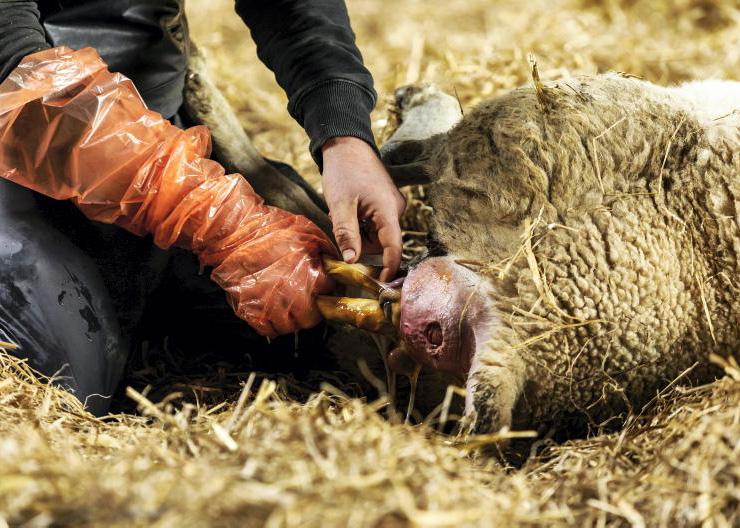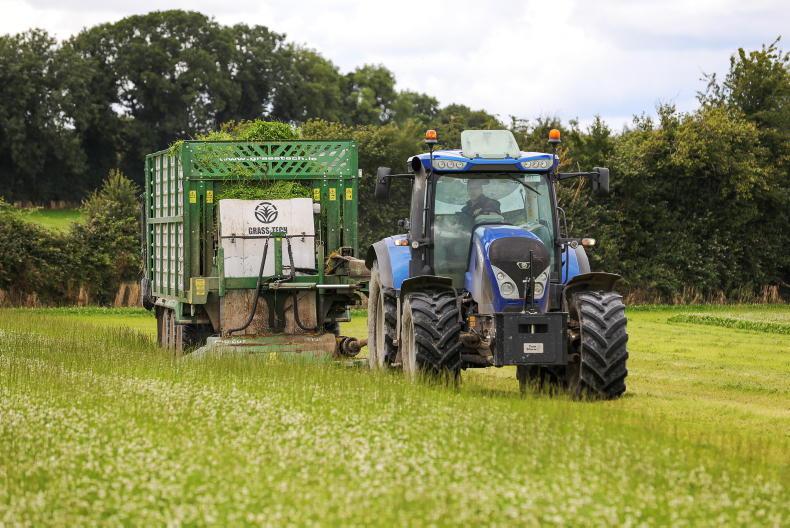Recent months have seen unprecedented increases in prices on global and Irish markets, with fertiliser, fuel and imported feed price rises of most concern to Irish farms.
The purpose of this article is to outline the cost of producing home-grown feeds on Irish farmers in 2022 and to compare this with the cost of purchased feed.
The Teagasc Grange Feed Model was used to determine the cost of producing eight of the most commonly grown feed crops in Ireland.
Based on current market prices, straight fertilisers were valued at €2.70/kg N for the purpose of the analysis.
Contracting costs were estimated based on the increases observed in fuel prices and other input prices (AdBlue, plastic, etc).
Compared to recent years, on average contracting costs rose by 56% in 2022.
These prices are those available in the final week of March 2022, but there is great volatility in the market at present, with indications that further upward movement may be possible.
Clearly, this would increase production costs above those obtained in this analysis.
The results of the estimated feed costs in spring 2022 are outlined in Table 1. Prices described in the following text include land charges, however prices excluding land charges are also presented in Table 1.
Costs are also presented per hectare per tonne (t) DM grown, and a relativity to grazed perennial ryegrass swards on a unit energy and unit DM. Supplementary feeding costs, particularly those associated with indoor feeding such as mineral and protein supplementation, are not accounted for in the analysis.
It has been well-established that the lowest cost feed in Ireland is grazed grass and this underpins our livestock systems, with the objective being to avail of this to the greatest extent over long grazing seasons. Perennial ryegrass swards have the potential to produce high yields of a highly digestible forage over a long growing season.
Typically this growth has been supported by nitrogen (N) application in the form of synthetic N such as urea or CAN or organic N in slurry and manure.
At current prices, a grazed grass sward yielding 13t of DM/hectare and receiving 250kg N/hectare (225kg urea N + 25kg organic N) is estimated to cost €121/t DM.
This represents a 29% increase on 2021, mostly driven by the increases in nitrogen fertiliser prices.
Legume crops such as white clover have the ability to ‘fix’ N from the atmosphere, thereby replacing to a large extent the requirement for imported N sources.
In this analysis, we assume that clover fixes 125kg atmospheric N/ha and therefore, N application is reduced to 125kg N/ha for a 13t DM grazed grass sward, reducing estimated total feed costs to €97/t DM.
This shows that successfully incorporating clover onto farms can be a strategic way to maintain herbage production, while allowing a decrease in fertiliser requirements on grazed pasture in future.
The costs of producing grass silage (pit) in this analysis is €204/t DM and €239/t DM for first and second cut respectively.
On average across the two cuts, harvested in late May and mid-July, grass silage is estimated to cost €218/t DM (around €47/t fresh weight), an increase of 31% when compared to 2021.
The cost of producing the same silage crop as a baled silage crop in 2022 is higher than pit silage at €232/t DM. This is equivalent to €46 per bale (€36 per bale excluding land charge), an increase of 31% compared to 2021.
The 2022 price increases are driven by the same factors as pit silage production, as well as the increased plastic and transport costs associated with baled silage production.
Feeds such as fodder beet and maize silage form an important part of the indoor feeding diet on many farms, particularly for finishers and winter milk systems.
The cost/t DM of fodder beet (including washing and chopping) in 2022 is similar to grass silage at €227/t DM (around €43/t fresh weight), representing an increase of 22% when compared to 2021.
Maize silage is marginally lower, costing €219/t DM grown (€66/t fresh weight), an increase of 31% when compared to 2021.
While the cost of home-produced feed has increased substantially, the rising cost of purchasing concentrate feeds is also noteworthy.
For example, rolled barley has increased in price to €390/t fresh weight in spring 2022.
When expressed on a dry matter basis and taking into account feed-out costs to be comparable to the forage crops evaluated, the total feed costs of concentrate rations is estimated to be €470/t DM.
This emphasises the importance of producing sufficient quantities of home-produced feeds, especially forages, and ensuring that the quality of feed produced is suitable for the animal type to be fed. If these two objectives are not achieved, then supplementary concentrate feeding will be necessary at a higher cost that the home-produced alternative.
There are some anecdotal reports of farmers choosing to reduce fertiliser application rates on grass silage crops.
Although the current cash flow situation is likely to dictate such decision-making, the longer-term impacts on farm finances need careful consideration also, particularly where more expensive imported supplementary feeds may be required to offset any shortfall in quantity or quality.
In this regard, detailed fodder budgeting is essential for this coming grazing and following indoor feeding seasons.
In summary, the cost of all feeds has increased substantially. Home-produced feeds, and grazed grass in particular, remain our cheapest feed resource with grass-clover pastures being particularly cost effective.
Following grazed grass, the costs of grass silage, fodder beet and maize silage are relatively similar when expressed on a per tonne basis.
Fodder beet and maize silage have somewhat lower production costs compared to grass silage when expressed on a per unit energy utilised basis (although these crops have a greater demand for protein and mineral supplementation, which is not included in this analysis, when compared to grass crops).
Purchased concentrates such as rolled barley remains an expensive feed resource, costing about five times the price of grazed grass on a per tonne DM basis or 3.9 times the cost of grazed grass on a per feed energy utilised basis.
Prices quoted in this article are estimates based on prevailing prices available at the time of the analysis (final week of March 2022) and are subject to high levels of volatility.
Analysis of eight of the most commonly grown feeds on Irish farms has shown that the rise in input prices has led to a substantial increase in feed costs between 22% and 31% in 2022 when compared to 2021.
Growing and efficiently utilising high-quality home-produced feed, rather than purchasing concentrates, which are also increasing in cost, remains the most cost-effective option for feeding livestock.Grazed grass is the lowest cost high-quality feed source available for livestock farmers, with clover inclusion in swards providing further opportunities to reduce costs.With rising supplementary feed costs, it is vital that farms produce sufficient winter feed of appropriate quality. In this regard, it is critical in the coming weeks that farmers close sufficient land area for first-cut silage, fertilise this area as required and harvest at the correct crop maturity to ensure quality targets are met.Targeting high grass utilisation on grassland farms across enterprises needs to be a key objective for the 2022 grazing season.
Recent months have seen unprecedented increases in prices on global and Irish markets, with fertiliser, fuel and imported feed price rises of most concern to Irish farms.
The purpose of this article is to outline the cost of producing home-grown feeds on Irish farmers in 2022 and to compare this with the cost of purchased feed.
The Teagasc Grange Feed Model was used to determine the cost of producing eight of the most commonly grown feed crops in Ireland.
Based on current market prices, straight fertilisers were valued at €2.70/kg N for the purpose of the analysis.
Contracting costs were estimated based on the increases observed in fuel prices and other input prices (AdBlue, plastic, etc).
Compared to recent years, on average contracting costs rose by 56% in 2022.
These prices are those available in the final week of March 2022, but there is great volatility in the market at present, with indications that further upward movement may be possible.
Clearly, this would increase production costs above those obtained in this analysis.
The results of the estimated feed costs in spring 2022 are outlined in Table 1. Prices described in the following text include land charges, however prices excluding land charges are also presented in Table 1.
Costs are also presented per hectare per tonne (t) DM grown, and a relativity to grazed perennial ryegrass swards on a unit energy and unit DM. Supplementary feeding costs, particularly those associated with indoor feeding such as mineral and protein supplementation, are not accounted for in the analysis.
It has been well-established that the lowest cost feed in Ireland is grazed grass and this underpins our livestock systems, with the objective being to avail of this to the greatest extent over long grazing seasons. Perennial ryegrass swards have the potential to produce high yields of a highly digestible forage over a long growing season.
Typically this growth has been supported by nitrogen (N) application in the form of synthetic N such as urea or CAN or organic N in slurry and manure.
At current prices, a grazed grass sward yielding 13t of DM/hectare and receiving 250kg N/hectare (225kg urea N + 25kg organic N) is estimated to cost €121/t DM.
This represents a 29% increase on 2021, mostly driven by the increases in nitrogen fertiliser prices.
Legume crops such as white clover have the ability to ‘fix’ N from the atmosphere, thereby replacing to a large extent the requirement for imported N sources.
In this analysis, we assume that clover fixes 125kg atmospheric N/ha and therefore, N application is reduced to 125kg N/ha for a 13t DM grazed grass sward, reducing estimated total feed costs to €97/t DM.
This shows that successfully incorporating clover onto farms can be a strategic way to maintain herbage production, while allowing a decrease in fertiliser requirements on grazed pasture in future.
The costs of producing grass silage (pit) in this analysis is €204/t DM and €239/t DM for first and second cut respectively.
On average across the two cuts, harvested in late May and mid-July, grass silage is estimated to cost €218/t DM (around €47/t fresh weight), an increase of 31% when compared to 2021.
The cost of producing the same silage crop as a baled silage crop in 2022 is higher than pit silage at €232/t DM. This is equivalent to €46 per bale (€36 per bale excluding land charge), an increase of 31% compared to 2021.
The 2022 price increases are driven by the same factors as pit silage production, as well as the increased plastic and transport costs associated with baled silage production.
Feeds such as fodder beet and maize silage form an important part of the indoor feeding diet on many farms, particularly for finishers and winter milk systems.
The cost/t DM of fodder beet (including washing and chopping) in 2022 is similar to grass silage at €227/t DM (around €43/t fresh weight), representing an increase of 22% when compared to 2021.
Maize silage is marginally lower, costing €219/t DM grown (€66/t fresh weight), an increase of 31% when compared to 2021.
While the cost of home-produced feed has increased substantially, the rising cost of purchasing concentrate feeds is also noteworthy.
For example, rolled barley has increased in price to €390/t fresh weight in spring 2022.
When expressed on a dry matter basis and taking into account feed-out costs to be comparable to the forage crops evaluated, the total feed costs of concentrate rations is estimated to be €470/t DM.
This emphasises the importance of producing sufficient quantities of home-produced feeds, especially forages, and ensuring that the quality of feed produced is suitable for the animal type to be fed. If these two objectives are not achieved, then supplementary concentrate feeding will be necessary at a higher cost that the home-produced alternative.
There are some anecdotal reports of farmers choosing to reduce fertiliser application rates on grass silage crops.
Although the current cash flow situation is likely to dictate such decision-making, the longer-term impacts on farm finances need careful consideration also, particularly where more expensive imported supplementary feeds may be required to offset any shortfall in quantity or quality.
In this regard, detailed fodder budgeting is essential for this coming grazing and following indoor feeding seasons.
In summary, the cost of all feeds has increased substantially. Home-produced feeds, and grazed grass in particular, remain our cheapest feed resource with grass-clover pastures being particularly cost effective.
Following grazed grass, the costs of grass silage, fodder beet and maize silage are relatively similar when expressed on a per tonne basis.
Fodder beet and maize silage have somewhat lower production costs compared to grass silage when expressed on a per unit energy utilised basis (although these crops have a greater demand for protein and mineral supplementation, which is not included in this analysis, when compared to grass crops).
Purchased concentrates such as rolled barley remains an expensive feed resource, costing about five times the price of grazed grass on a per tonne DM basis or 3.9 times the cost of grazed grass on a per feed energy utilised basis.
Prices quoted in this article are estimates based on prevailing prices available at the time of the analysis (final week of March 2022) and are subject to high levels of volatility.
Analysis of eight of the most commonly grown feeds on Irish farms has shown that the rise in input prices has led to a substantial increase in feed costs between 22% and 31% in 2022 when compared to 2021.
Growing and efficiently utilising high-quality home-produced feed, rather than purchasing concentrates, which are also increasing in cost, remains the most cost-effective option for feeding livestock.Grazed grass is the lowest cost high-quality feed source available for livestock farmers, with clover inclusion in swards providing further opportunities to reduce costs.With rising supplementary feed costs, it is vital that farms produce sufficient winter feed of appropriate quality. In this regard, it is critical in the coming weeks that farmers close sufficient land area for first-cut silage, fertilise this area as required and harvest at the correct crop maturity to ensure quality targets are met.Targeting high grass utilisation on grassland farms across enterprises needs to be a key objective for the 2022 grazing season. 








SHARING OPTIONS